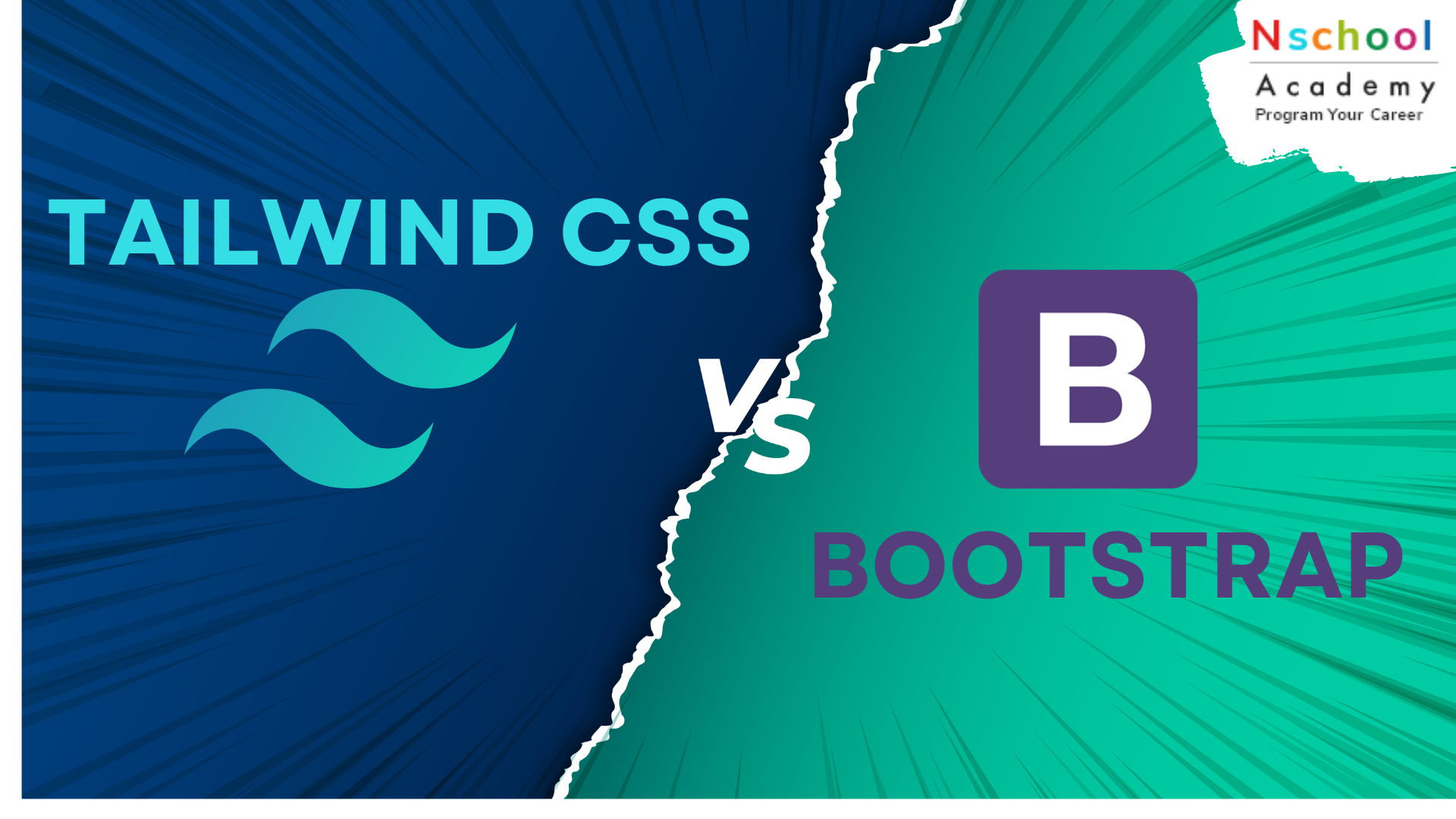Bootstrap vs. Tailwind CSS: Which CSS Framework Fits Your Needs?
- June 28, 2024
- nschool
- 0

Introduction
In this blog let us look about Tailwind CSS vs Bootstrap. In the world of web development, two popular frameworks stand out for their ability to streamline the design process: Tailwind CSS vs Bootstrap. Each offers a distinct approach to building user interfaces, catering to different preferences and workflows. Bootstrap, known for its comprehensive pre-designed components and grid system, provides a structured framework that speeds up development with ready-to-use classes. On the other hand, Tailwind CSS takes a utility-first approach, offering a more customizable experience by giving developers direct control over each design decision through utility classes. Whether you prefer the convenience of pre-styled components or the flexibility of granular control, both frameworks empower developers to create responsive and visually appealing websites efficiently.
What is Bootstrap?
Bootstrap is a popular front-end framework used by developers to create responsive and visually appealing websites and web applications. It provides a collection of pre-designed HTML, CSS, and JavaScript components that help streamline the process of building user interfaces. Bootstrap’s key feature is its grid system, which allows developers to create responsive layouts easily by organizing content into rows and columns. Additionally, Bootstrap offers a variety of UI components such as navigation bars, buttons, forms, and modal windows, all styled consistently to ensure a cohesive design across the application. This framework is known for its ease of use and extensive documentation, making it a favorite among developers looking to build modern and responsive websites efficiently.
Key features of Bootstrap:
Responsive Grid System: Bootstrap includes a responsive, mobile-first fluid grid system that scales up to 12 columns as the viewport or device size increases. This grid system simplifies the creation of responsive layouts by allowing content to easily adapt to different screen sizes.
Pre-styled Components: It provides a comprehensive set of pre-styled HTML and CSS components such as navigation bars, buttons, forms, cards, and carousels. These components are designed to be visually appealing and consistent across different browsers and devices, saving developers time and effort in styling.
Customizable Themes: Bootstrap allows developers to customize the appearance of their websites by leveraging Bootstrap’s extensive Sass variables and mixins. This flexibility enables developers to create unique designs while still benefiting from Bootstrap’s underlying structure and functionality.
JavaScript Plugins: Bootstrap includes several JavaScript plugins like modals, tooltips, carousels, and dropdowns. These plugins enhance the user experience and add interactive elements to web pages without requiring extensive JavaScript coding.
Documentation and Community Support: Bootstrap is well-documented with clear examples and guidelines, making it easy for developers of all skill levels to get started quickly. Additionally, it has a large and active community of developers who contribute plugins, themes, and provide support through forums and online resources.
Advantages of Bootstrap:
Rapid Development: Bootstrap allows developers to quickly prototype and build responsive websites using its pre-designed components and grid system.
Responsive Design: Bootstrap’s grid system ensures that websites are automatically responsive, adjusting layout and content to fit different screen sizes and devices, which is essential for modern web applications.
Consistency: It provides a set of consistent UI components and styles, ensuring a uniform look and feel across the application. This consistency helps maintain a professional appearance and improves user experience.
Customization: While Bootstrap comes with predefined styles, it also allows for customization through Sass variables, allowing developers to create unique designs while leveraging Bootstrap’s structure and functionality.
Extensive Documentation and Support: Bootstrap has comprehensive documentation, tutorials, and a large community of developers. This makes it easy to learn, troubleshoot issues, and find solutions quickly.
Cross-Browser Compatibility: Bootstrap is designed to work smoothly across different browsers, reducing compatibility issues and ensuring a consistent experience for users.
Disadvantages of Bootstrap:
Generic Look: Since Bootstrap is widely used, websites built with default Bootstrap styles may look similar to other Bootstrap-based sites. Customization is required to create a distinct visual identity.
File Size: Bootstrap’s comprehensive framework and included JavaScript plugins can lead to larger file sizes compared to minimalist frameworks, potentially impacting page load times.
Learning Curve: While Bootstrap is beginner-friendly, mastering its full capabilities and customization options can require time and effort, especially for developers new to front-end frameworks.
Dependency on JavaScript: Some Bootstrap components rely heavily on JavaScript, which may increase page load times and require additional optimization for performance-critical applications.
Overhead for Simple Projects: For small or simple projects, using Bootstrap may introduce unnecessary complexity and overhead due to its comprehensive feature set.
Updates and Maintenance: Updating Bootstrap to newer versions or maintaining customizations across updates can sometimes be challenging, requiring careful management to avoid breaking changes.
What is Tailwind CSS?
Tailwind CSS revolutionizes frontend development with its utility-first approach, offering a wide array of atomic classes that directly apply styles to HTML elements. By leveraging classes like flex, grid, and rounded, developers gain precise control over design elements without writing custom CSS. This methodology enhances collaboration between designers and developers, promotes consistency across projects, and accelerates the development process. Tailwind’s configurability through its tailwind.config.js file further tailors styles, making it a versatile choice for creating responsive, modern web applications.
Key features of Tailwind CSS include:
Utility-First Approach: Instead of predefined components, Tailwind CSS provides utility classes that directly apply CSS styles. For example, classes like bg-blue-500 for background color or py-4 for padding on the y-axis can be used to style elements without writing custom CSS.
Responsive Design: Tailwind CSS includes responsive utilities that allow developers to apply different styles based on screen size breakpoints. This ensures that applications are responsive and optimized for various devices.
Customization: Tailwind CSS is highly customizable through configuration files. Developers can define their own utility classes, theme colors, spacing scales, and more, tailoring the framework to match specific project requirements.
Developer Experience: The framework enhances developer productivity with features like IntelliSense support in editors, which provides auto-completion and documentation hints for Tailwind CSS classes.
Performance: Tailwind CSS is designed to generate small, optimized CSS bundles by only including styles that are used in the project. This helps in reducing the overall file size and improving loading times.
Community and Ecosystem: Tailwind CSS has a growing community that contributes plugins, extensions, and integrations with popular tools and frameworks, expanding its functionality and usability.
Advantages of Tailwind CSS:
Utility-First Approach: Tailwind CSS uses utility classes directly in HTML to style elements, allowing for rapid prototyping and easy customization without writing custom CSS. This approach provides granular control over styling elements.
Customization: Tailwind CSS is highly customizable through its configuration file. Developers can define custom utility classes, theme colors, spacing scales, and more, tailoring the framework to match specific design requirements.
Performance: Tailwind CSS generates small CSS bundles by only including the styles that are used in the project. This optimized approach helps in reducing the overall file size and improving loading times, which is beneficial for performance-sensitive applications.
Flexibility: The utility-first approach allows for flexible design options and encourages creativity in design without being constrained by predefined components or styles. Developers can create unique designs quickly and efficiently.
Responsive Design: Tailwind CSS includes responsive utilities that make it easy to create responsive layouts and designs, adapting seamlessly to different screen sizes and devices.
Developer Experience: Tailwind CSS enhances developer productivity with features like IntelliSense support in editors, which provides auto-completion and documentation hints for Tailwind CSS classes. This aids in faster development and reduces the learning curve for new developers.
Disadvantages of Tailwind CSS:
Learning Curve: Initially, developers may find it challenging to shift from traditional CSS or component-based frameworks like Bootstrap to the utility-first approach of Tailwind CSS. Understanding and using utility classes effectively requires some learning and adjustment.
File Size in Development: While Tailwind CSS optimizes file size for production by only including used styles, during development, the CSS file can become large due to the inclusion of all utility classes. This can make the development phase slower until unused styles are purged for production.
Design Consistency: Since Tailwind CSS relies on utility classes, maintaining design consistency across different components and pages might require careful planning and adherence to a consistent design system.
Complexity in Large Projects: In larger projects, managing and organizing a large number of utility classes can become challenging without proper structuring and documentation. It’s important to establish conventions and best practices for team collaboration.
Dependency on HTML Structure: Tailwind CSS’s utility-first approach requires embedding styles directly in HTML, which can make the HTML code more verbose and potentially less semantic compared to separate CSS files.
Tooling Requirements: Tailwind CSS requires build tools like Post CSS or Purge CSS to effectively optimize the CSS file size for production. Setting up and configuring these tools may require additional setup and learning.
Tailwind CSS vs Bootstrap
Feature | Tailwind CSS | Bootstrap |
Styling Approach | Utility-first approach: Uses utility classes directly in HTML for styling (e.g., bg-blue-500, p-4) | Component-based approach: Provides pre-designed components (e.g., buttons, cards) with predefined styles. |
| Customization | Highly customizable through configuration files, allowing developers to define custom utility classes, themes, and styles. | Customization available but primarily through overriding default styles or using Sass variables for theming. |
| Developer Experience | Offers improved developer experience with IntelliSense support and streamlined workflows for rapid prototyping and customization. | Well-documented with extensive examples and a large community, making it beginner-friendly and widely supported. |
| Responsive Design | Responsive utilities enable easy adaptation to different screen sizes and breakpoints, ensuring mobile-first design principles. | Responsive grid system simplifies layout creation with predefined grid classes that adapt to screen sizes |
| File Size | Generates small CSS bundles by only including styles that are used, optimizing performance and reducing file size. | Larger file size due to bundled components and additional JavaScript plugins, potentially impacting performance. |
| Learning Curve | Requires familiarity with utility classes and may have a steeper learning curve initially for developers used to traditional CSS frameworks. | Easier learning curve with pre-designed components and straightforward grid system, suitable for beginners. |
Conclusion
Selecting between Bootstrap vs Tailwind CSS hinges on your project’s specifics. Bootstrap excels in rapid prototyping and maintaining consistency across designs, with a vast community and ready-to-use components. Conversely, Tailwind CSS offers unparalleled customization and performance optimization through its utility-first approach, ideal for projects needing unique, efficient designs. Understanding your development priorities—whether it’s ease of use and community support (Bootstrap) or flexibility and performance (Tailwind CSS)—is crucial in determining which framework best fits your needs.

